Comprehensive Taxation Law Report: Capital Gains Tax and Allowances
VerifiedAdded on 2021/02/21
|7
|1825
|135
Report
AI Summary
This report provides an in-depth analysis of taxation law, specifically focusing on capital gains tax (CGT) and capital allowances. The report begins with an introduction to tax laws and their application, followed by a detailed examination of CGT, addressing scenarios related to family homes, cars, business sales, and the sale of paintings. It clarifies the application of CGT based on the ITAA 1997 and ATO guidelines. The second part of the report delves into capital allowances, defining them as tax relief for capital expenditure. It addresses issues related to depreciation, including the determination of asset costs and the commencement of depreciation charges for a CNC machine. The report concludes by summarizing the treatment of different items concerning CGT and capital allowances, emphasizing the importance of timings in asset inclusion and exclusion. The analysis is supported by relevant legal principles and their practical application, effectively demonstrating the nuances of tax law concepts. The report references key legal documents, including the ITAA 1997 and various ATO guidelines, to support its findings and conclusions.
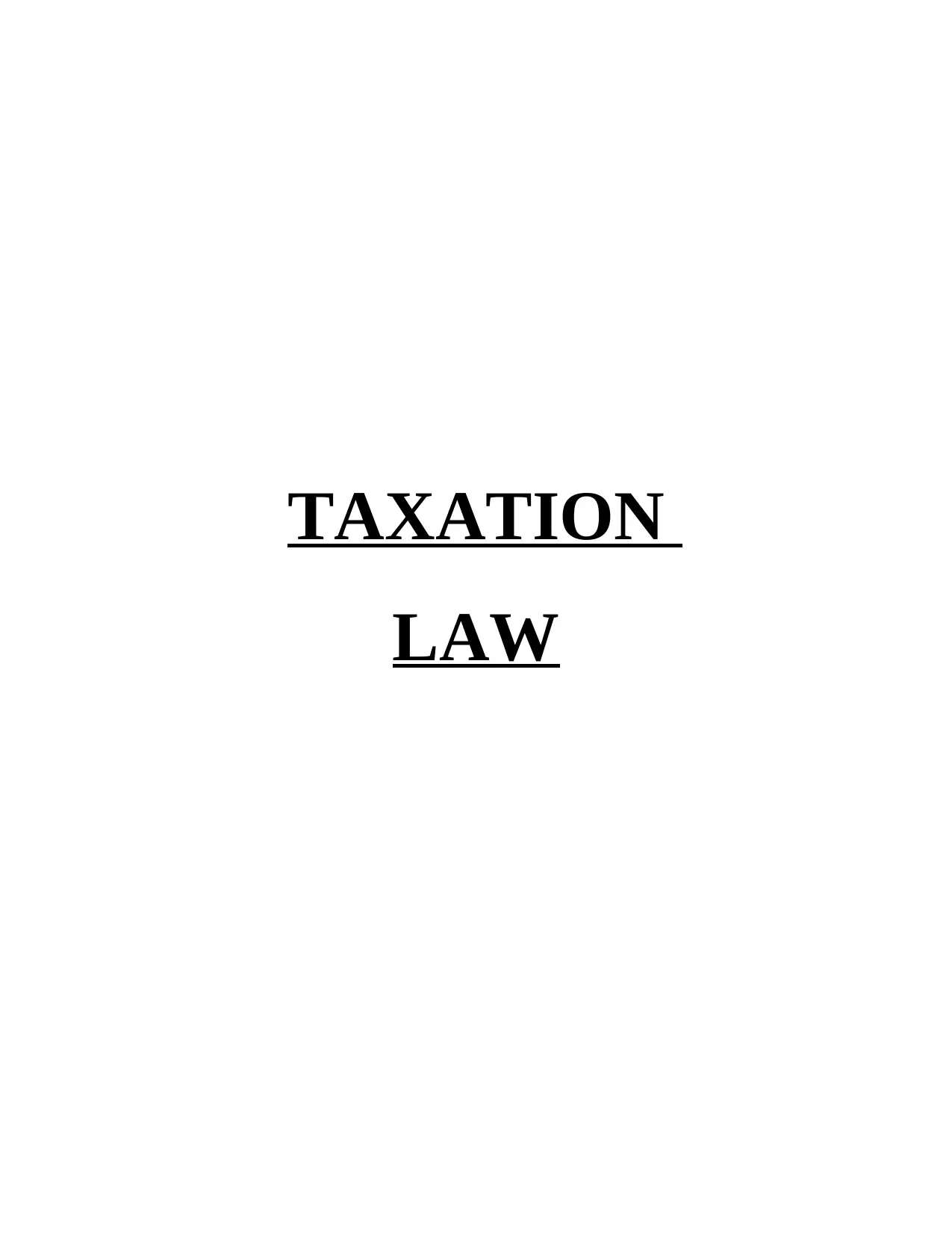
TAXATION
LAW
LAW
Paraphrase This Document
Need a fresh take? Get an instant paraphrase of this document with our AI Paraphraser
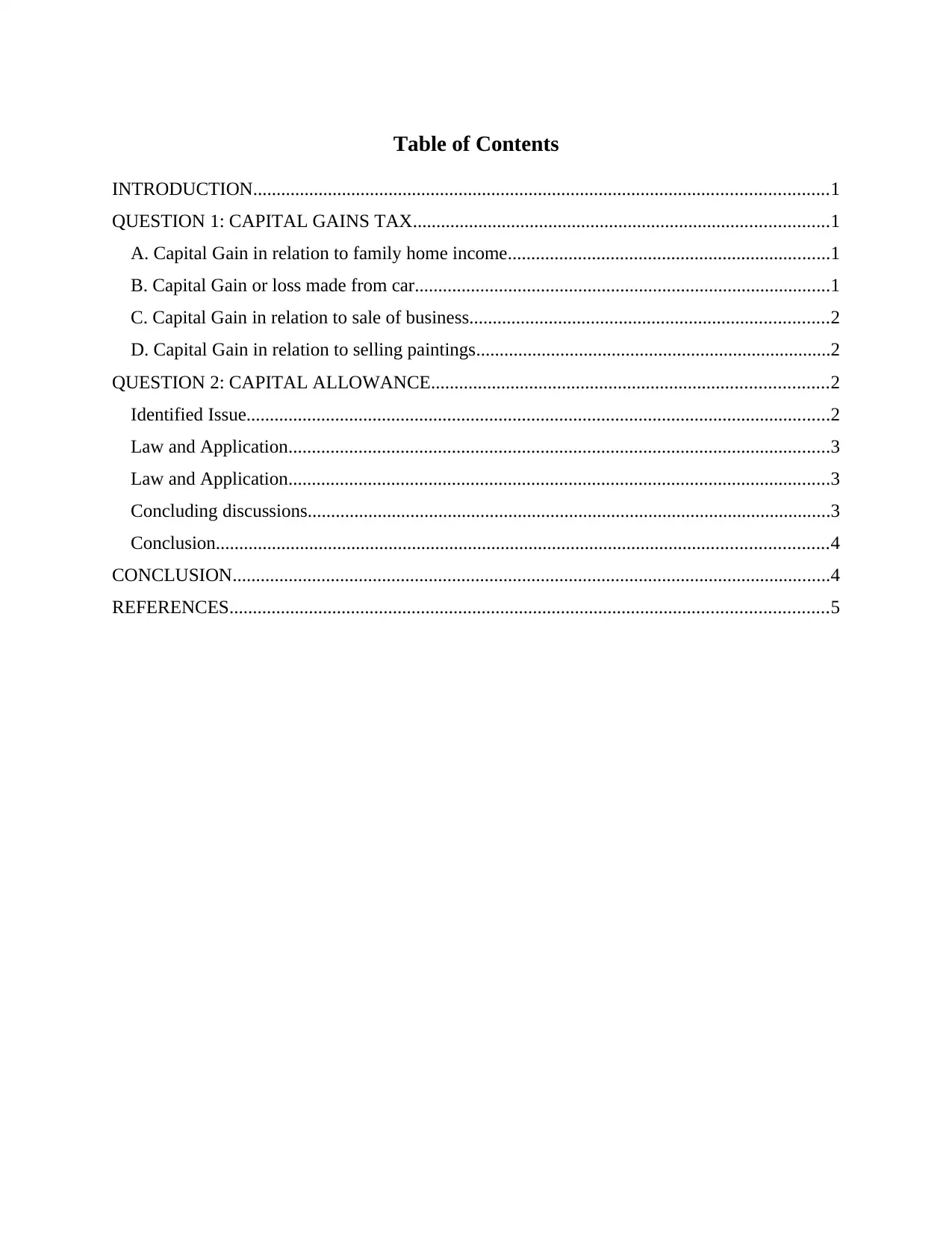
Table of Contents
INTRODUCTION...........................................................................................................................1
QUESTION 1: CAPITAL GAINS TAX.........................................................................................1
A. Capital Gain in relation to family home income.....................................................................1
B. Capital Gain or loss made from car.........................................................................................1
C. Capital Gain in relation to sale of business.............................................................................2
D. Capital Gain in relation to selling paintings............................................................................2
QUESTION 2: CAPITAL ALLOWANCE.....................................................................................2
Identified Issue.............................................................................................................................2
Law and Application....................................................................................................................3
Law and Application....................................................................................................................3
Concluding discussions................................................................................................................3
Conclusion...................................................................................................................................4
CONCLUSION................................................................................................................................4
REFERENCES................................................................................................................................5
INTRODUCTION...........................................................................................................................1
QUESTION 1: CAPITAL GAINS TAX.........................................................................................1
A. Capital Gain in relation to family home income.....................................................................1
B. Capital Gain or loss made from car.........................................................................................1
C. Capital Gain in relation to sale of business.............................................................................2
D. Capital Gain in relation to selling paintings............................................................................2
QUESTION 2: CAPITAL ALLOWANCE.....................................................................................2
Identified Issue.............................................................................................................................2
Law and Application....................................................................................................................3
Law and Application....................................................................................................................3
Concluding discussions................................................................................................................3
Conclusion...................................................................................................................................4
CONCLUSION................................................................................................................................4
REFERENCES................................................................................................................................5
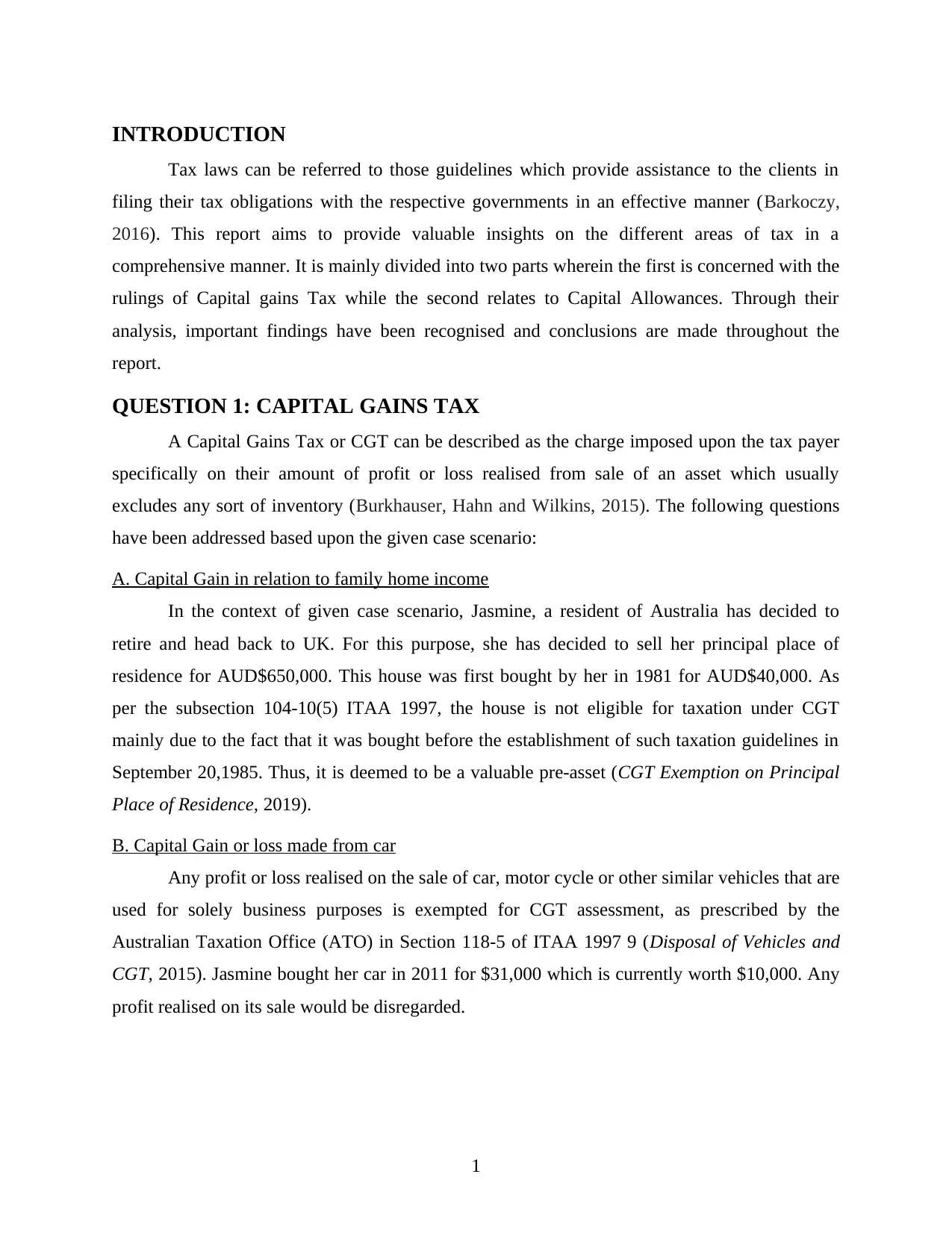
INTRODUCTION
Tax laws can be referred to those guidelines which provide assistance to the clients in
filing their tax obligations with the respective governments in an effective manner (Barkoczy,
2016). This report aims to provide valuable insights on the different areas of tax in a
comprehensive manner. It is mainly divided into two parts wherein the first is concerned with the
rulings of Capital gains Tax while the second relates to Capital Allowances. Through their
analysis, important findings have been recognised and conclusions are made throughout the
report.
QUESTION 1: CAPITAL GAINS TAX
A Capital Gains Tax or CGT can be described as the charge imposed upon the tax payer
specifically on their amount of profit or loss realised from sale of an asset which usually
excludes any sort of inventory (Burkhauser, Hahn and Wilkins, 2015). The following questions
have been addressed based upon the given case scenario:
A. Capital Gain in relation to family home income
In the context of given case scenario, Jasmine, a resident of Australia has decided to
retire and head back to UK. For this purpose, she has decided to sell her principal place of
residence for AUD$650,000. This house was first bought by her in 1981 for AUD$40,000. As
per the subsection 104-10(5) ITAA 1997, the house is not eligible for taxation under CGT
mainly due to the fact that it was bought before the establishment of such taxation guidelines in
September 20,1985. Thus, it is deemed to be a valuable pre-asset (CGT Exemption on Principal
Place of Residence, 2019).
B. Capital Gain or loss made from car
Any profit or loss realised on the sale of car, motor cycle or other similar vehicles that are
used for solely business purposes is exempted for CGT assessment, as prescribed by the
Australian Taxation Office (ATO) in Section 118-5 of ITAA 1997 9 (Disposal of Vehicles and
CGT, 2015). Jasmine bought her car in 2011 for $31,000 which is currently worth $10,000. Any
profit realised on its sale would be disregarded.
1
Tax laws can be referred to those guidelines which provide assistance to the clients in
filing their tax obligations with the respective governments in an effective manner (Barkoczy,
2016). This report aims to provide valuable insights on the different areas of tax in a
comprehensive manner. It is mainly divided into two parts wherein the first is concerned with the
rulings of Capital gains Tax while the second relates to Capital Allowances. Through their
analysis, important findings have been recognised and conclusions are made throughout the
report.
QUESTION 1: CAPITAL GAINS TAX
A Capital Gains Tax or CGT can be described as the charge imposed upon the tax payer
specifically on their amount of profit or loss realised from sale of an asset which usually
excludes any sort of inventory (Burkhauser, Hahn and Wilkins, 2015). The following questions
have been addressed based upon the given case scenario:
A. Capital Gain in relation to family home income
In the context of given case scenario, Jasmine, a resident of Australia has decided to
retire and head back to UK. For this purpose, she has decided to sell her principal place of
residence for AUD$650,000. This house was first bought by her in 1981 for AUD$40,000. As
per the subsection 104-10(5) ITAA 1997, the house is not eligible for taxation under CGT
mainly due to the fact that it was bought before the establishment of such taxation guidelines in
September 20,1985. Thus, it is deemed to be a valuable pre-asset (CGT Exemption on Principal
Place of Residence, 2019).
B. Capital Gain or loss made from car
Any profit or loss realised on the sale of car, motor cycle or other similar vehicles that are
used for solely business purposes is exempted for CGT assessment, as prescribed by the
Australian Taxation Office (ATO) in Section 118-5 of ITAA 1997 9 (Disposal of Vehicles and
CGT, 2015). Jasmine bought her car in 2011 for $31,000 which is currently worth $10,000. Any
profit realised on its sale would be disregarded.
1
⊘ This is a preview!⊘
Do you want full access?
Subscribe today to unlock all pages.

Trusted by 1+ million students worldwide
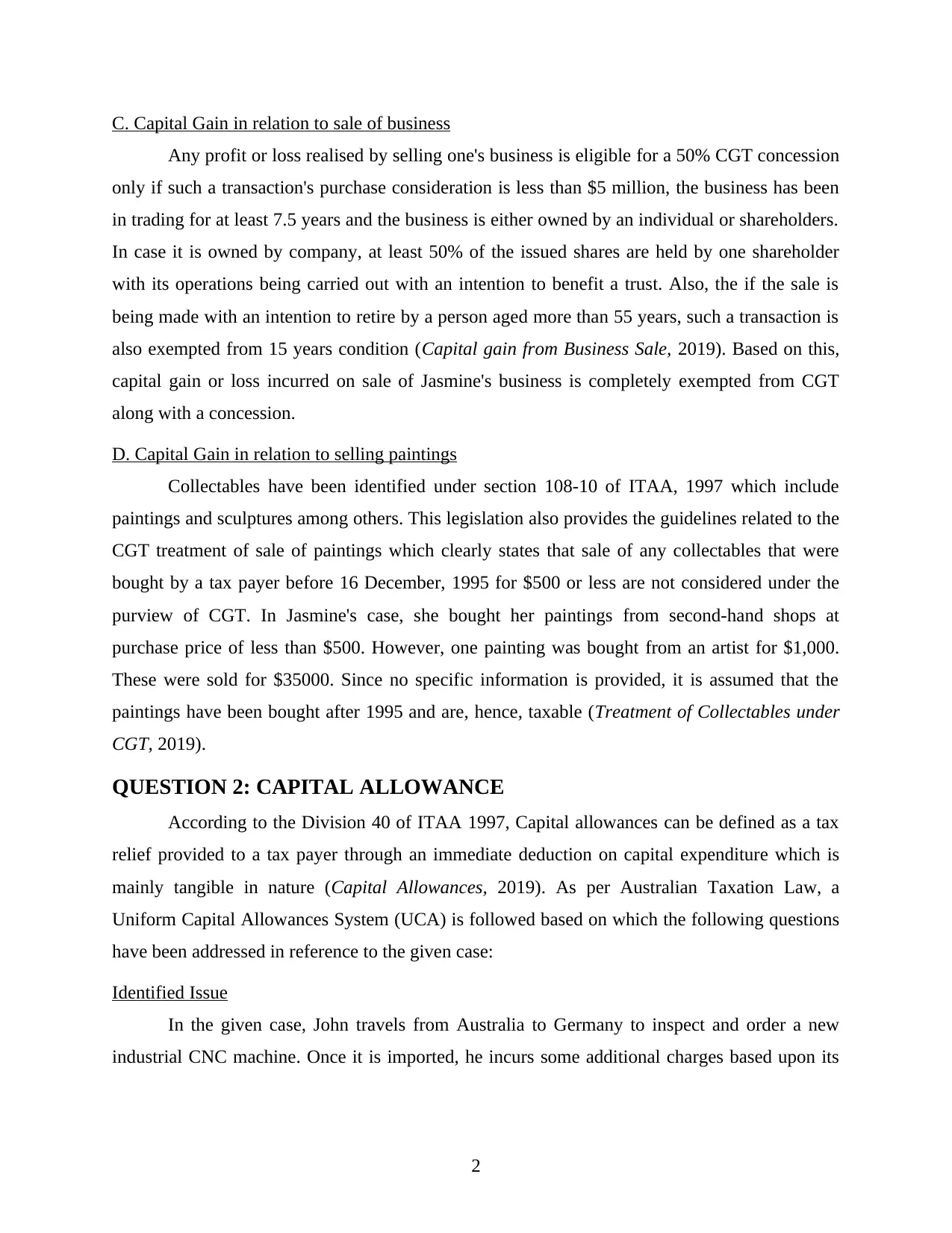
C. Capital Gain in relation to sale of business
Any profit or loss realised by selling one's business is eligible for a 50% CGT concession
only if such a transaction's purchase consideration is less than $5 million, the business has been
in trading for at least 7.5 years and the business is either owned by an individual or shareholders.
In case it is owned by company, at least 50% of the issued shares are held by one shareholder
with its operations being carried out with an intention to benefit a trust. Also, the if the sale is
being made with an intention to retire by a person aged more than 55 years, such a transaction is
also exempted from 15 years condition (Capital gain from Business Sale, 2019). Based on this,
capital gain or loss incurred on sale of Jasmine's business is completely exempted from CGT
along with a concession.
D. Capital Gain in relation to selling paintings
Collectables have been identified under section 108-10 of ITAA, 1997 which include
paintings and sculptures among others. This legislation also provides the guidelines related to the
CGT treatment of sale of paintings which clearly states that sale of any collectables that were
bought by a tax payer before 16 December, 1995 for $500 or less are not considered under the
purview of CGT. In Jasmine's case, she bought her paintings from second-hand shops at
purchase price of less than $500. However, one painting was bought from an artist for $1,000.
These were sold for $35000. Since no specific information is provided, it is assumed that the
paintings have been bought after 1995 and are, hence, taxable (Treatment of Collectables under
CGT, 2019).
QUESTION 2: CAPITAL ALLOWANCE
According to the Division 40 of ITAA 1997, Capital allowances can be defined as a tax
relief provided to a tax payer through an immediate deduction on capital expenditure which is
mainly tangible in nature (Capital Allowances, 2019). As per Australian Taxation Law, a
Uniform Capital Allowances System (UCA) is followed based on which the following questions
have been addressed in reference to the given case:
Identified Issue
In the given case, John travels from Australia to Germany to inspect and order a new
industrial CNC machine. Once it is imported, he incurs some additional charges based upon its
2
Any profit or loss realised by selling one's business is eligible for a 50% CGT concession
only if such a transaction's purchase consideration is less than $5 million, the business has been
in trading for at least 7.5 years and the business is either owned by an individual or shareholders.
In case it is owned by company, at least 50% of the issued shares are held by one shareholder
with its operations being carried out with an intention to benefit a trust. Also, the if the sale is
being made with an intention to retire by a person aged more than 55 years, such a transaction is
also exempted from 15 years condition (Capital gain from Business Sale, 2019). Based on this,
capital gain or loss incurred on sale of Jasmine's business is completely exempted from CGT
along with a concession.
D. Capital Gain in relation to selling paintings
Collectables have been identified under section 108-10 of ITAA, 1997 which include
paintings and sculptures among others. This legislation also provides the guidelines related to the
CGT treatment of sale of paintings which clearly states that sale of any collectables that were
bought by a tax payer before 16 December, 1995 for $500 or less are not considered under the
purview of CGT. In Jasmine's case, she bought her paintings from second-hand shops at
purchase price of less than $500. However, one painting was bought from an artist for $1,000.
These were sold for $35000. Since no specific information is provided, it is assumed that the
paintings have been bought after 1995 and are, hence, taxable (Treatment of Collectables under
CGT, 2019).
QUESTION 2: CAPITAL ALLOWANCE
According to the Division 40 of ITAA 1997, Capital allowances can be defined as a tax
relief provided to a tax payer through an immediate deduction on capital expenditure which is
mainly tangible in nature (Capital Allowances, 2019). As per Australian Taxation Law, a
Uniform Capital Allowances System (UCA) is followed based on which the following questions
have been addressed in reference to the given case:
Identified Issue
In the given case, John travels from Australia to Germany to inspect and order a new
industrial CNC machine. Once it is imported, he incurs some additional charges based upon its
2
Paraphrase This Document
Need a fresh take? Get an instant paraphrase of this document with our AI Paraphraser
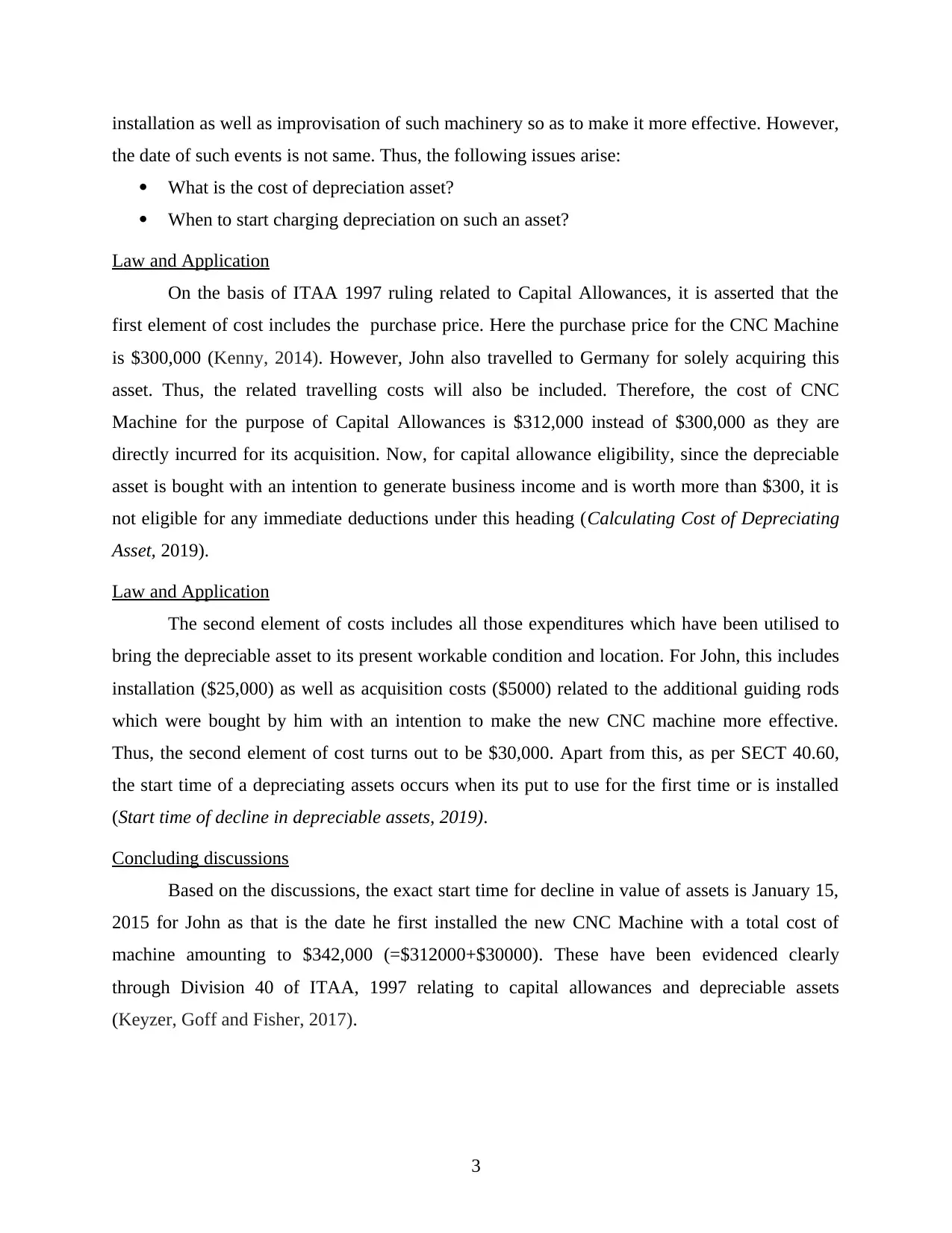
installation as well as improvisation of such machinery so as to make it more effective. However,
the date of such events is not same. Thus, the following issues arise:
What is the cost of depreciation asset?
When to start charging depreciation on such an asset?
Law and Application
On the basis of ITAA 1997 ruling related to Capital Allowances, it is asserted that the
first element of cost includes the purchase price. Here the purchase price for the CNC Machine
is $300,000 (Kenny, 2014). However, John also travelled to Germany for solely acquiring this
asset. Thus, the related travelling costs will also be included. Therefore, the cost of CNC
Machine for the purpose of Capital Allowances is $312,000 instead of $300,000 as they are
directly incurred for its acquisition. Now, for capital allowance eligibility, since the depreciable
asset is bought with an intention to generate business income and is worth more than $300, it is
not eligible for any immediate deductions under this heading (Calculating Cost of Depreciating
Asset, 2019).
Law and Application
The second element of costs includes all those expenditures which have been utilised to
bring the depreciable asset to its present workable condition and location. For John, this includes
installation ($25,000) as well as acquisition costs ($5000) related to the additional guiding rods
which were bought by him with an intention to make the new CNC machine more effective.
Thus, the second element of cost turns out to be $30,000. Apart from this, as per SECT 40.60,
the start time of a depreciating assets occurs when its put to use for the first time or is installed
(Start time of decline in depreciable assets, 2019).
Concluding discussions
Based on the discussions, the exact start time for decline in value of assets is January 15,
2015 for John as that is the date he first installed the new CNC Machine with a total cost of
machine amounting to $342,000 (=$312000+$30000). These have been evidenced clearly
through Division 40 of ITAA, 1997 relating to capital allowances and depreciable assets
(Keyzer, Goff and Fisher, 2017).
3
the date of such events is not same. Thus, the following issues arise:
What is the cost of depreciation asset?
When to start charging depreciation on such an asset?
Law and Application
On the basis of ITAA 1997 ruling related to Capital Allowances, it is asserted that the
first element of cost includes the purchase price. Here the purchase price for the CNC Machine
is $300,000 (Kenny, 2014). However, John also travelled to Germany for solely acquiring this
asset. Thus, the related travelling costs will also be included. Therefore, the cost of CNC
Machine for the purpose of Capital Allowances is $312,000 instead of $300,000 as they are
directly incurred for its acquisition. Now, for capital allowance eligibility, since the depreciable
asset is bought with an intention to generate business income and is worth more than $300, it is
not eligible for any immediate deductions under this heading (Calculating Cost of Depreciating
Asset, 2019).
Law and Application
The second element of costs includes all those expenditures which have been utilised to
bring the depreciable asset to its present workable condition and location. For John, this includes
installation ($25,000) as well as acquisition costs ($5000) related to the additional guiding rods
which were bought by him with an intention to make the new CNC machine more effective.
Thus, the second element of cost turns out to be $30,000. Apart from this, as per SECT 40.60,
the start time of a depreciating assets occurs when its put to use for the first time or is installed
(Start time of decline in depreciable assets, 2019).
Concluding discussions
Based on the discussions, the exact start time for decline in value of assets is January 15,
2015 for John as that is the date he first installed the new CNC Machine with a total cost of
machine amounting to $342,000 (=$312000+$30000). These have been evidenced clearly
through Division 40 of ITAA, 1997 relating to capital allowances and depreciable assets
(Keyzer, Goff and Fisher, 2017).
3
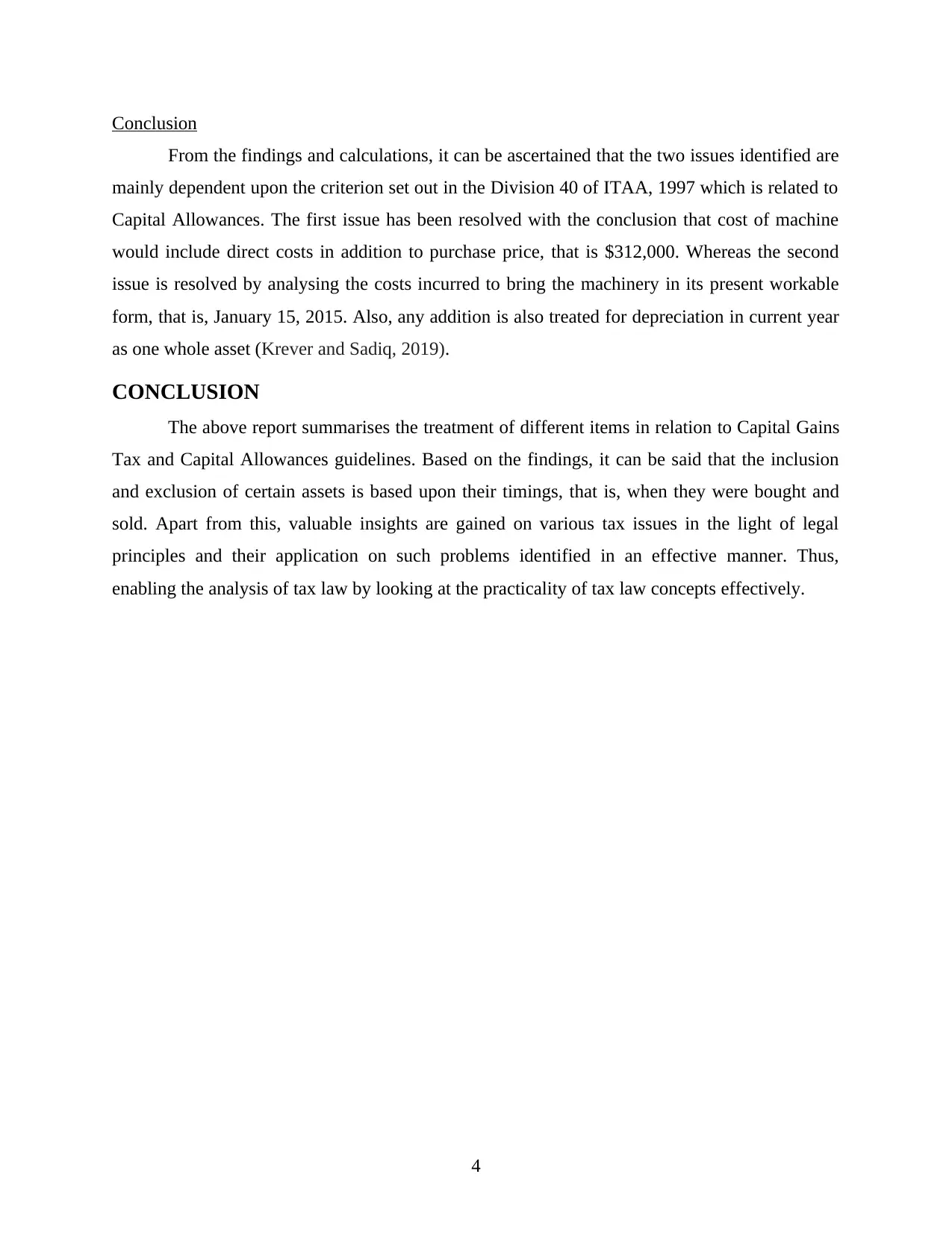
Conclusion
From the findings and calculations, it can be ascertained that the two issues identified are
mainly dependent upon the criterion set out in the Division 40 of ITAA, 1997 which is related to
Capital Allowances. The first issue has been resolved with the conclusion that cost of machine
would include direct costs in addition to purchase price, that is $312,000. Whereas the second
issue is resolved by analysing the costs incurred to bring the machinery in its present workable
form, that is, January 15, 2015. Also, any addition is also treated for depreciation in current year
as one whole asset (Krever and Sadiq, 2019).
CONCLUSION
The above report summarises the treatment of different items in relation to Capital Gains
Tax and Capital Allowances guidelines. Based on the findings, it can be said that the inclusion
and exclusion of certain assets is based upon their timings, that is, when they were bought and
sold. Apart from this, valuable insights are gained on various tax issues in the light of legal
principles and their application on such problems identified in an effective manner. Thus,
enabling the analysis of tax law by looking at the practicality of tax law concepts effectively.
4
From the findings and calculations, it can be ascertained that the two issues identified are
mainly dependent upon the criterion set out in the Division 40 of ITAA, 1997 which is related to
Capital Allowances. The first issue has been resolved with the conclusion that cost of machine
would include direct costs in addition to purchase price, that is $312,000. Whereas the second
issue is resolved by analysing the costs incurred to bring the machinery in its present workable
form, that is, January 15, 2015. Also, any addition is also treated for depreciation in current year
as one whole asset (Krever and Sadiq, 2019).
CONCLUSION
The above report summarises the treatment of different items in relation to Capital Gains
Tax and Capital Allowances guidelines. Based on the findings, it can be said that the inclusion
and exclusion of certain assets is based upon their timings, that is, when they were bought and
sold. Apart from this, valuable insights are gained on various tax issues in the light of legal
principles and their application on such problems identified in an effective manner. Thus,
enabling the analysis of tax law by looking at the practicality of tax law concepts effectively.
4
⊘ This is a preview!⊘
Do you want full access?
Subscribe today to unlock all pages.

Trusted by 1+ million students worldwide
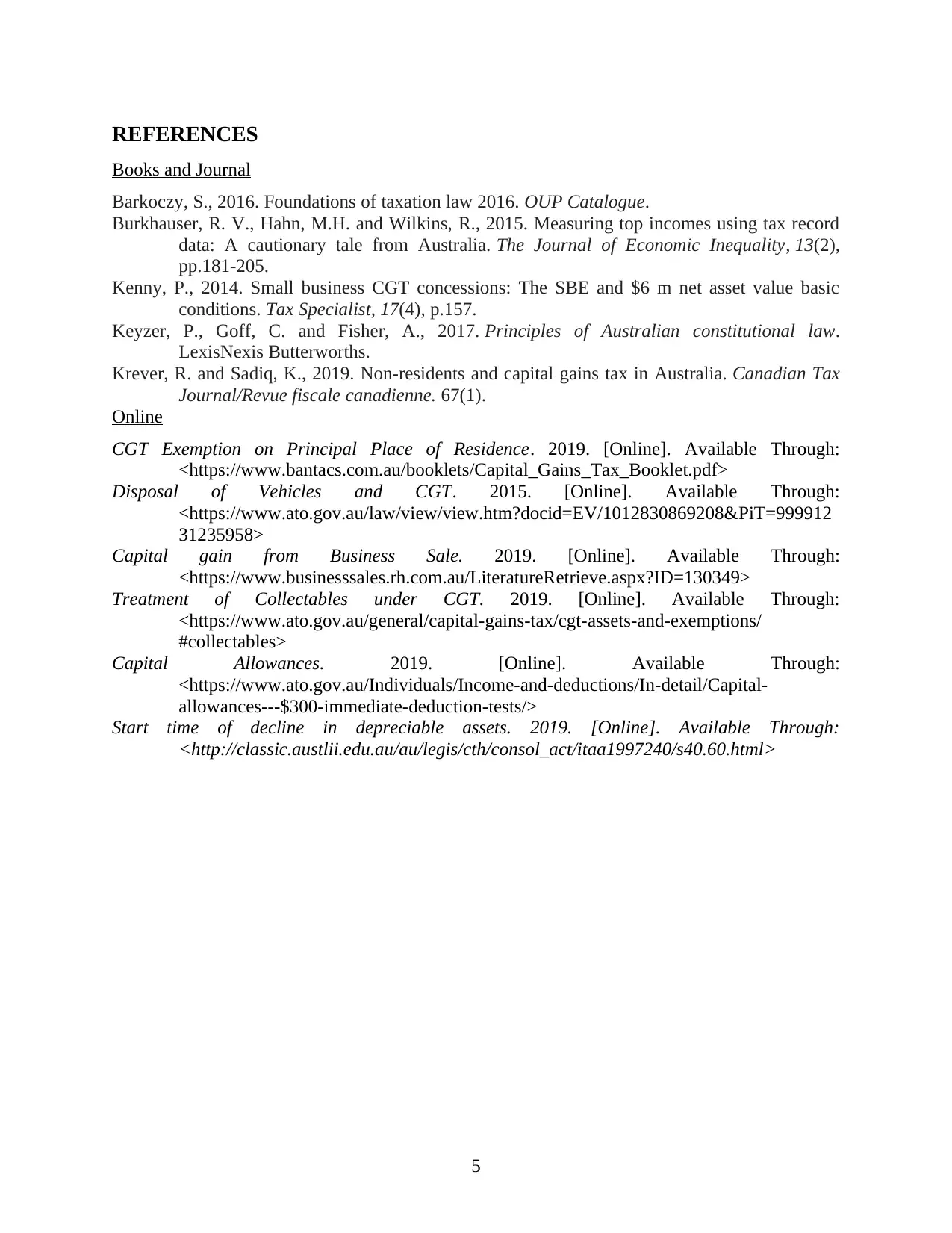
REFERENCES
Books and Journal
Barkoczy, S., 2016. Foundations of taxation law 2016. OUP Catalogue.
Burkhauser, R. V., Hahn, M.H. and Wilkins, R., 2015. Measuring top incomes using tax record
data: A cautionary tale from Australia. The Journal of Economic Inequality, 13(2),
pp.181-205.
Kenny, P., 2014. Small business CGT concessions: The SBE and $6 m net asset value basic
conditions. Tax Specialist, 17(4), p.157.
Keyzer, P., Goff, C. and Fisher, A., 2017. Principles of Australian constitutional law.
LexisNexis Butterworths.
Krever, R. and Sadiq, K., 2019. Non-residents and capital gains tax in Australia. Canadian Tax
Journal/Revue fiscale canadienne. 67(1).
Online
CGT Exemption on Principal Place of Residence. 2019. [Online]. Available Through:
<https://www.bantacs.com.au/booklets/Capital_Gains_Tax_Booklet.pdf>
Disposal of Vehicles and CGT. 2015. [Online]. Available Through:
<https://www.ato.gov.au/law/view/view.htm?docid=EV/1012830869208&PiT=999912
31235958>
Capital gain from Business Sale. 2019. [Online]. Available Through:
<https://www.businesssales.rh.com.au/LiteratureRetrieve.aspx?ID=130349>
Treatment of Collectables under CGT. 2019. [Online]. Available Through:
<https://www.ato.gov.au/general/capital-gains-tax/cgt-assets-and-exemptions/
#collectables>
Capital Allowances. 2019. [Online]. Available Through:
<https://www.ato.gov.au/Individuals/Income-and-deductions/In-detail/Capital-
allowances---$300-immediate-deduction-tests/>
Start time of decline in depreciable assets. 2019. [Online]. Available Through:
<http://classic.austlii.edu.au/au/legis/cth/consol_act/itaa1997240/s40.60.html>
5
Books and Journal
Barkoczy, S., 2016. Foundations of taxation law 2016. OUP Catalogue.
Burkhauser, R. V., Hahn, M.H. and Wilkins, R., 2015. Measuring top incomes using tax record
data: A cautionary tale from Australia. The Journal of Economic Inequality, 13(2),
pp.181-205.
Kenny, P., 2014. Small business CGT concessions: The SBE and $6 m net asset value basic
conditions. Tax Specialist, 17(4), p.157.
Keyzer, P., Goff, C. and Fisher, A., 2017. Principles of Australian constitutional law.
LexisNexis Butterworths.
Krever, R. and Sadiq, K., 2019. Non-residents and capital gains tax in Australia. Canadian Tax
Journal/Revue fiscale canadienne. 67(1).
Online
CGT Exemption on Principal Place of Residence. 2019. [Online]. Available Through:
<https://www.bantacs.com.au/booklets/Capital_Gains_Tax_Booklet.pdf>
Disposal of Vehicles and CGT. 2015. [Online]. Available Through:
<https://www.ato.gov.au/law/view/view.htm?docid=EV/1012830869208&PiT=999912
31235958>
Capital gain from Business Sale. 2019. [Online]. Available Through:
<https://www.businesssales.rh.com.au/LiteratureRetrieve.aspx?ID=130349>
Treatment of Collectables under CGT. 2019. [Online]. Available Through:
<https://www.ato.gov.au/general/capital-gains-tax/cgt-assets-and-exemptions/
#collectables>
Capital Allowances. 2019. [Online]. Available Through:
<https://www.ato.gov.au/Individuals/Income-and-deductions/In-detail/Capital-
allowances---$300-immediate-deduction-tests/>
Start time of decline in depreciable assets. 2019. [Online]. Available Through:
<http://classic.austlii.edu.au/au/legis/cth/consol_act/itaa1997240/s40.60.html>
5
1 out of 7
Related Documents
Your All-in-One AI-Powered Toolkit for Academic Success.
+13062052269
info@desklib.com
Available 24*7 on WhatsApp / Email
![[object Object]](/_next/static/media/star-bottom.7253800d.svg)
Unlock your academic potential
Copyright © 2020–2025 A2Z Services. All Rights Reserved. Developed and managed by ZUCOL.





